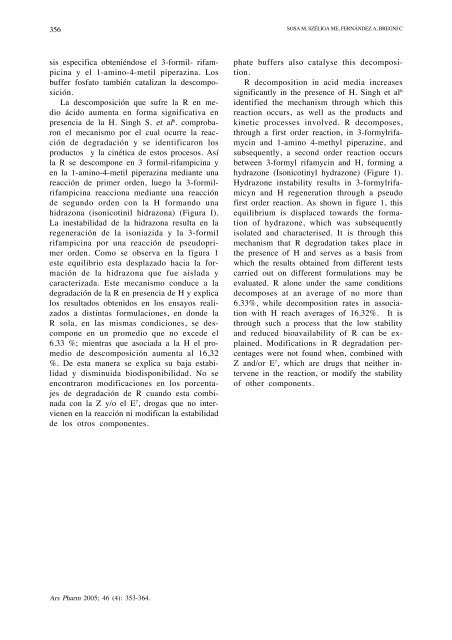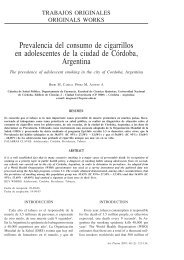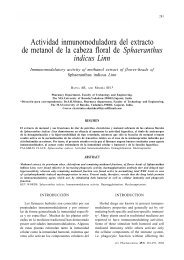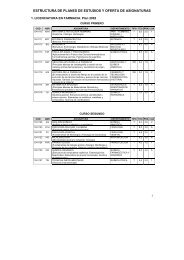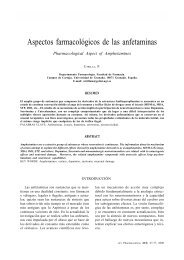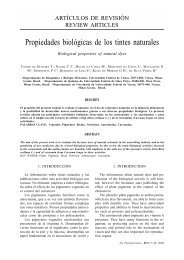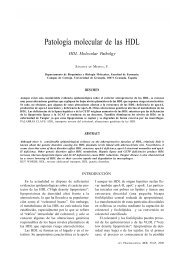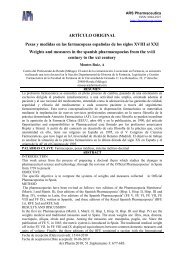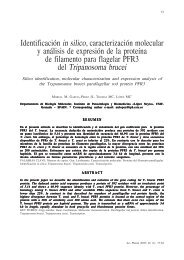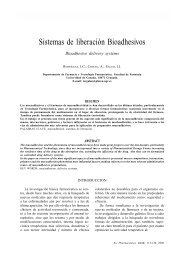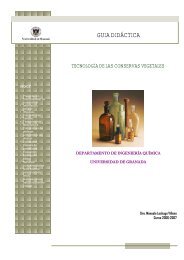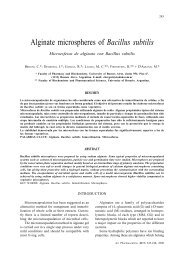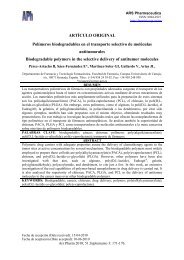Rifampicina y biodisponibilidad en productos combinados
Rifampicina y biodisponibilidad en productos combinados
Rifampicina y biodisponibilidad en productos combinados
Create successful ePaper yourself
Turn your PDF publications into a flip-book with our unique Google optimized e-Paper software.
356<br />
sis especifica obt<strong>en</strong>iéndose el 3-formil- rifampicina<br />
y el 1-amino-4-metil piperazina. Los<br />
buffer fosfato también catalizan la descomposición.<br />
La descomposición que sufre la R <strong>en</strong> medio<br />
ácido aum<strong>en</strong>ta <strong>en</strong> forma significativa <strong>en</strong><br />
pres<strong>en</strong>cia de la H. Singh S. et al 6 . comprobaron<br />
el mecanismo por el cual ocurre la reacción<br />
de degradación y se id<strong>en</strong>tificaron los<br />
<strong>productos</strong> y la cinética de estos procesos. Así<br />
la R se descompone <strong>en</strong> 3 formil-rifampicina y<br />
<strong>en</strong> la 1-amino-4-metil piperazina mediante una<br />
reacción de primer ord<strong>en</strong>, luego la 3-formilrifampicina<br />
reacciona mediante una reacción<br />
de segundo ord<strong>en</strong> con la H formando una<br />
hidrazona (isonicotinil hidrazona) (Figura I).<br />
La inestabilidad de la hidrazona resulta <strong>en</strong> la<br />
reg<strong>en</strong>eración de la isoniazida y la 3-formil<br />
rifampicina por una reacción de pseudoprimer<br />
ord<strong>en</strong>. Como se observa <strong>en</strong> la figura 1<br />
este equilibrio esta desplazado hacia la formación<br />
de la hidrazona que fue aislada y<br />
caracterizada. Este mecanismo conduce a la<br />
degradación de la R <strong>en</strong> pres<strong>en</strong>cia de H y explica<br />
los resultados obt<strong>en</strong>idos <strong>en</strong> los <strong>en</strong>sayos realizados<br />
a distintas formulaciones, <strong>en</strong> donde la<br />
R sola, <strong>en</strong> las mismas condiciones, se descompone<br />
<strong>en</strong> un promedio que no excede el<br />
6.33 %; mi<strong>en</strong>tras que asociada a la H el promedio<br />
de descomposición aum<strong>en</strong>ta al 16,32<br />
%. De esta manera se explica su baja estabilidad<br />
y disminuida <strong>biodisponibilidad</strong>. No se<br />
<strong>en</strong>contraron modificaciones <strong>en</strong> los porc<strong>en</strong>tajes<br />
de degradación de R cuando esta combinada<br />
con la Z y/o el E 7 , drogas que no intervi<strong>en</strong><strong>en</strong><br />
<strong>en</strong> la reacción ni modifican la estabilidad<br />
de los otros compon<strong>en</strong>tes.<br />
Ars Pharm 2005; 46 (4): 353-364.<br />
SOSA M, SZÉLIGA ME, FERNÁNDEZ A, BREGNI C<br />
phate buffers also catalyse this decomposition.<br />
R decomposition in acid media increases<br />
significantly in the pres<strong>en</strong>ce of H. Singh et al 6<br />
id<strong>en</strong>tified the mechanism through which this<br />
reaction occurs, as well as the products and<br />
kinetic processes involved. R decomposes,<br />
through a first order reaction, in 3-formylrifamycin<br />
and 1-amino 4-methyl piperazine, and<br />
subsequ<strong>en</strong>tly, a second order reaction occurs<br />
betwe<strong>en</strong> 3-formyl rifamycin and H, forming a<br />
hydrazone (Isonicotinyl hydrazone) (Figure 1).<br />
Hydrazone instability results in 3-formylrifamicyn<br />
and H reg<strong>en</strong>eration through a pseudo<br />
first order reaction. As shown in figure 1, this<br />
equilibrium is displaced towards the formation<br />
of hydrazone, which was subsequ<strong>en</strong>tly<br />
isolated and characterised. It is through this<br />
mechanism that R degradation takes place in<br />
the pres<strong>en</strong>ce of H and serves as a basis from<br />
which the results obtained from differ<strong>en</strong>t tests<br />
carried out on differ<strong>en</strong>t formulations may be<br />
evaluated. R alone under the same conditions<br />
decomposes at an average of no more than<br />
6.33%, while decomposition rates in association<br />
with H reach averages of 16.32%. It is<br />
through such a process that the low stability<br />
and reduced bioavailability of R can be explained.<br />
Modifications in R degradation perc<strong>en</strong>tages<br />
were not found wh<strong>en</strong>, combined with<br />
Z and/or E 7 , which are drugs that neither interv<strong>en</strong>e<br />
in the reaction, or modify the stability<br />
of other compon<strong>en</strong>ts.


